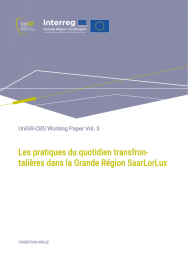Working Paper Vol. 5

This paper analyses everyday practices carried out by the residents of the Saarland, Lorraine, Luxembourg, Rhineland-Palatinate and Wallonia in the neighbouring regions abroad. The key assumption is the consideration that the inhabitants of the Greater Region SaarLorLux define the transborder reality of life of this region through their cross-border performance of everyday practices. Such a socio-constructivist perspective is not interested in what the Greater Region SaarLorLux actually is, but in what ways it is constituted or how it manifests itself in the daily lives of its inhabitants. Therefor the most common cross-border everyday practices, such as shopping for everyday needs, leisure-time shopping, outdoor recreation/tourism, cultural events, as well as visiting friends and family are looked at in greater detail. These observations are based on selected findings from three recent empirical studies of the study region, which have been linked to each other as well as socio-culturally and socioeconomically mapped in order to carve out the spatial organization, the motives and other contextual factors of cross-border everyday practices in the Greater Region SaarLorLux. This approach allows reconstructing mobility flows and spatial emphases in the context of everyday practices and gives insights into the nature of cross-border living realities in the Greater Region SaarLorLux.

